长江口是我国最大的河流入海口, 地理位置特殊, 渔业资源丰富, 是多种鱼、虾、蟹类的繁殖、索饵场所和许多洄游鱼类的必经之路, 其主要经济种类有刀鲚和日本鳗鲡等[1-3]。近几十年来, 受生活废水、船舶污染、农田排污、工业污染等因素影响[4], 长江口环境问题日益突出, 而水体环境的变化对仔稚鱼群落结构的分布至关重要, 因此, 为确保长江口渔业资源的可持续发展, 对长江口仔稚鱼相关的生物学研究刻不容缓。
鱼类的早期生活史是指鱼类生活史中成活率最低的卵、仔鱼和稚鱼等3个发育期[5-6], 早期渔业资源是指处于早期生活史阶段的鱼类资源。早期鱼类资源的生物量是引起鱼类种群数量变动和种类组成的重要因素, 是衡量某一水域鱼类的繁殖群体规模及未来种群变动趋势的重要指标[7-8]。以处于早期生活史的鱼类为研究对象, 进行渔业资源的相关生态学研究, 是鱼类资源保护生态学研究的重要方法。近年来, 鱼类早期资源的相关调查研究主要涉及鱼卵以及仔稚鱼个体的种类组成和分布。刘守海等[9]对长江口流域夏季的仔稚鱼进行了采样分析, 共鉴定到17种仔稚鱼类, 隶属于8目13科。丁月旻等[10]应用单元和多元分析法对长江口及其邻近水域拖网采集的仔稚鱼群落进行了调查分析, 共获得27个种类的仔稚鱼, 隶属5目14科, 并通过相关分析表明了盐度可能是造成长江河口仔稚鱼群落结构时空差异性的主要原因。钟俊生等[11]于2004年3月—2005年3月, 利用小型拖网对长江口沿岸的碎波带进行了调查分析, 共采集到仔稚鱼6 892尾, 约50种, 隶属于23科。蒋日进等[12]于2006年7月—2007年6月在长江口沿岸碎波带设立13个站位点进行了表层拖尾采样, 共采集到仔稚鱼49 045尾, 隶属于31科84种。李安东[13]为探明长江口南支刀鲚仔稚鱼的丰度和分布变化, 于2014年3—9月在长江口南支采用大型仔稚鱼网进行大潮期间月表层拖网调查, 共采集到刀鲚仔稚鱼1 270尾, 体长范围为3.56~50.88 mm, 发育阶段为卵黄囊期仔鱼期到稚鱼。处于早期发育阶段的鱼类由于鳍条发育不完全, 游泳能力弱, 只能被迫随潮汐漂流移动, 因此, 潮汐和水域径流量对仔稚鱼群落的分布存在很大程度的影响。受浮游植物、浮游动物等食物营养的影响, 仔稚鱼的分布也与水域温度、盐度等环境因子有关[14-15]。因此, 本文基于潮汐、昼夜、表中水层仔稚鱼的密度分布差异, 分析了光照、饵料条件、水域温度等环境因子对仔稚鱼群落的分布影响, 旨在为长江口南支早期渔业资源的保护提供科学依据。
1 材料与方法 1.1 样品采集在长江口南支南北纵向断面设置2个站位点(St.1:31°35.500'N, 121°20.004'E; St.2:31°33.500'N, 121°20.000'E, 图 1), 于2017年5月—2018年4月每月大潮期间进行调查, 每次调查从上午第1次涨潮开始, 使用大型仔稚鱼网(口径1.3 m, 网目0.5 mm)进行水平拖网采集, 渔船:沪崇渔10688, 48.7 kW, 拖速:2 kn, 全天涨潮、退潮各进行4次采集(平潮期间不采集), 在每站位的每次采集分别进行“表、中层”(调查水域实际水深的1/2确定中层位置)拖网1次, 每次拖网10 min, 总计拖网32次, 用网口流量计(KC Denmark A/S Model 23.090)记录拖网流量值。现场用体积分数为5%的甲醛海水溶液固定样品, 测量并记录各站位点表层和中层的水温、盐度和溶氧量等数据。
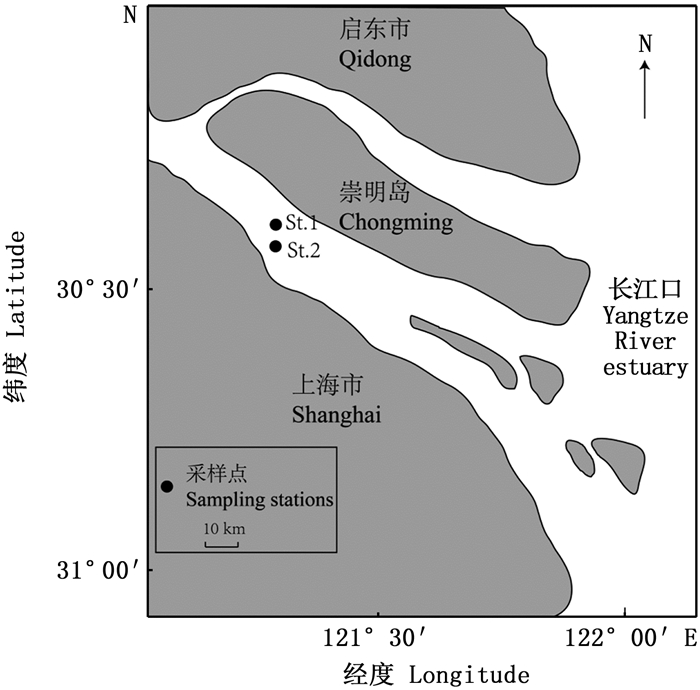
|
图 1 采样站点分布 Fig. 1 Sampling stations |
采用Olympus SZX7解剖镜鉴定样品分类到科、属、种[16-21], 按KENDALL等[22]的仔稚鱼发育阶段分期标准划分各发育阶段并分别计数, 仔稚鱼发育阶段划分为卵黄囊期、前弯曲期、弯曲期、后弯曲期以及稚鱼期。各发育阶段的特征为卵黄囊期:仔稚鱼孵化出现卵黄; 前弯曲期:卵黄消失, 脊索末端呈直线形; 弯曲期:脊索末端上弯, 尾下骨出现至末端与体轴倾斜; 后弯曲期:脊索末端上弯, 尾下骨末端与体轴垂直; 稚鱼期:鳍完成, 趋于成体之形态或鳞片开始出现。测量各鱼体体长, 计算各网次平均密度(尾/1 000 m3)。科名按NELSON等[23], 学名按照伍汉霖等[24], 并确定其生态类型[25]。
1.3 数据统计仔稚鱼密度的计算公式:
 (1)
(1)
式中:Ga为单位体积水体中仔稚鱼个体数, 尾/1 000 m3; Na为全网仔稚鱼个体数, 尾; S为网口面积, m2; L为流量计转数; C为流量计校正值(C=0.3)[26]。
1.4 相关性分析利用IBM SPSS 20对温度、溶解氧浓度等环境因子与仔稚鱼平均密度进行Pearson相关性分析(若相关系数|r|为0.8~1.0, 则两变量间具有极显著相关性; 若相关系数|r|为0.6~0.8, 则两变量间具有显著相关性; 若相关系数|r|为0.4~0.6, 则两变量间具有中度相关性; 若相关系数|r|为0.2~0.4, 则两变量间具有弱相关性; 若相关系数|r|为0~0.2, 则两变量间极弱相关或不相关。
所有的数据统计分析均使用Excel 2016、IBM SPSS 20完成。
2 结果 2.1 种类组成全年拖网384网次, 共采集到仔稚鱼51 783尾, 隶属于8科32种, 见表 1。各捕获量占总渔获量的比例分别为(1)生态类型方面:淡水性鱼类21种, 占比99.82%;半咸水鱼类7种, 占比2.15%;近海鱼类4种, 占比0.18%。(2)分类地位方面:鲤科鱼类15种, 占比94.83%;虾虎鱼科4种, 占比2.21%;胡瓜鱼科4种, 占比0.10%;鲿科2种, 占比0.47%;鳀科、鱵科、鲻科、狼鲈科、真鲈科、䲗科、舌鳎科均为1种, 占比分别为0.77%、0.25%、0.14%、0.06%、0.08%、0.98%、0.08%。(3)优势种占比:贝氏䱗的个体数最多, 占比为87.05%, 其余依次为鲫3.45%、翘嘴鲌3.16%、子陵吻虾虎鱼2.16%、香䲗0.01%, 以上5种鱼共占总体渔获量的95.83%。

|
表 1 长江口南支仔稚鱼种类组成 Tab.1 Species composition of fish larvae and juveniles in the south branch of Yangtze River estuary |
采集到的仔稚鱼随潮汐变化趋势:涨潮时, 5—6月有所下降, 6—7月显著上升, 7—8月显著下降, 从9月开始渔获密度逐渐降低, 在同年12月至次年4月达到最低; 退潮时, 渔获密度在5—7月逐月上升, 7—8月显著下降, 从9月开始渔获密度逐渐降低, 在同年12月至次年4月达到最低。全年仔稚鱼渔获主要集中在5—9月, 其中7月渔获量最多(29 605尾), 其涨潮、退潮时的平均密度均为全年最高, 分别为2 609.3尾/1 000 m3、1 316.1尾/1 000 m3。2月涨潮及1—3月退潮时平均密度最低, 均为0.1尾/1 000 m3。从整体变化来看, 涨潮时的平均密度总体高于退潮时。见图 2。
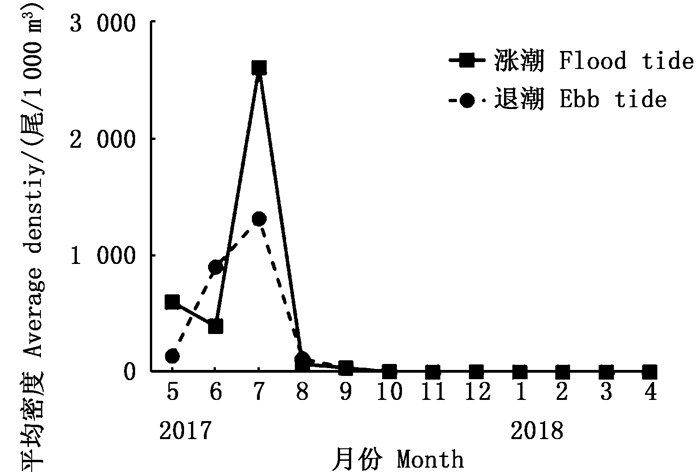
|
图 2 长江口南支水域仔稚鱼平均密度的涨退潮月变化 Fig. 2 Monthly variation of average density inthe southern branch of Yangtze River estuary |
2017年7月白天涨潮时仔稚鱼密度最高, 为5 064.71尾/1 000 m3(表 2); 表层涨潮时仔稚鱼密度最高, 为4 806.41尾/1 000 m3(表 3)。此外, 2017年5—9月均表现出相对较高的平均密度, 2017年10月开始降低, 2018年1—4月最低, 出现多网次无渔获。

|
表 2 长江口南支水域仔稚鱼密度的昼夜月变化 Tab.2 Monthly variations of species density offish larvae and juveniles at day and night in thesouth branch of Yangtze River estuary |

|
表 3 长江口南支水域仔稚鱼密度的表、中层月变化 Tab.3 Monthly variations in species density of fishlarvae and juveniles in the surface and middle layersin the south branch of Yangtze River estuary |
根据昼夜、潮汐、表中水层, 长江口南支贝氏䱗仔稚鱼体长在夜间的整体分布略大于白天, 表层略大于中层, 在2017年10月—2018年1月及2018年3月无贝氏䱗仔稚鱼渔获, 全年贝氏䱗体长从4月开始呈逐月上升趋势, 见图 3, 4。
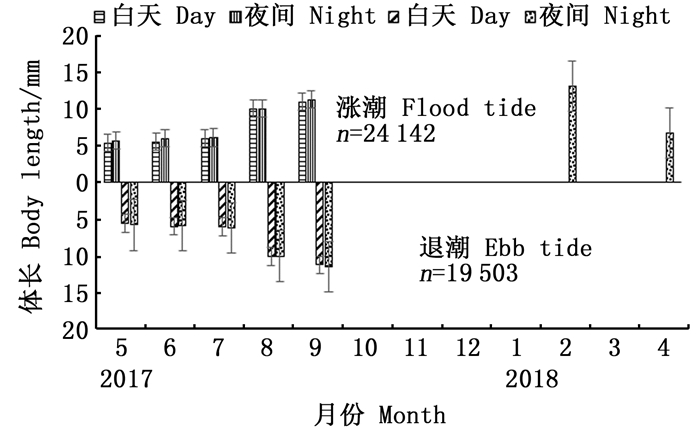
|
图 3 贝氏䱗各月涨退潮的昼、夜体长变化分布 Fig. 3 Monthly variations in body length distribution of Hemiculter bleekeri at day and night in thesouth branch of Yangtze River estuary |

|
图 4 贝氏䱗各月涨退潮的表、中层体长变化分布 Fig. 4 Monthly variations in body length distribution of Hemiculter bleekeri in the surface and middlelayers in the south branch of Yangtze River estuary |
鲫仔稚鱼体长在夜间的整体分布大于白天, 表中层无明显差异, 除2017年6月、10月以及2017年12月—2018年3月无鲫仔稚鱼渔获外, 鲫仔稚鱼体长的整体分布表现为5月、6月体长差异较小, 7月、8月、9月、11月鲫仔稚鱼体长差异较小, 见图 5, 6。
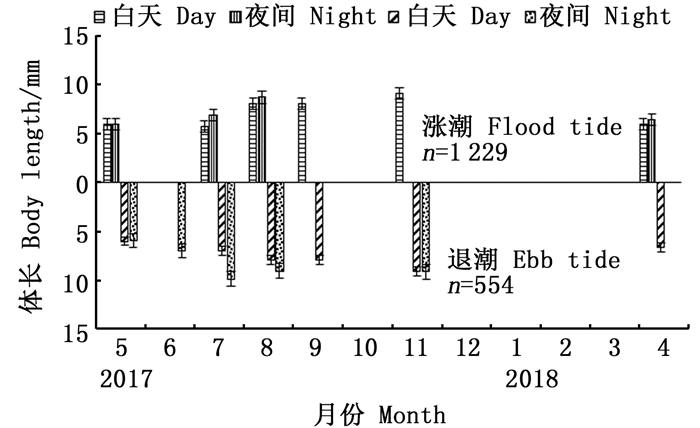
|
图 5 鲫各月涨退潮的昼、夜体长变化分布 Fig. 5 Monthly variations in body length distribution of Carassius auratus at day and night in thesouth branch of Yangtze River estuary |
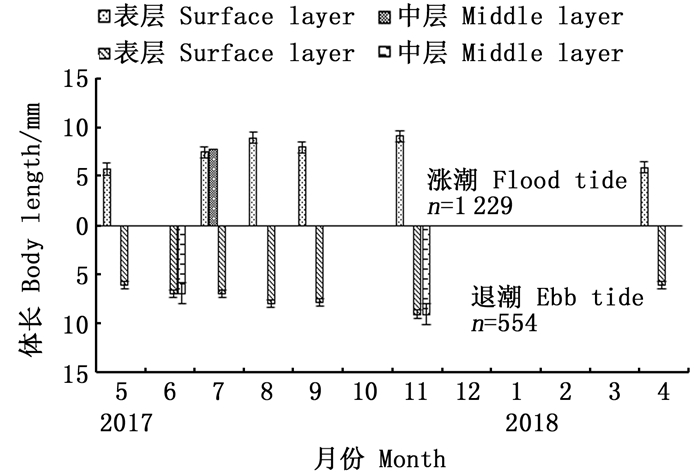
|
图 6 鲫各月涨退潮的表、中层体长变化分布 Fig. 6 Monthly variations in body length distribution of Carassius auratus in the surface and middle layersin the south branch of Yangtze River estuary |
翘嘴鲌仔稚鱼体长在夜间的整体分布大于白天, 涨潮时表、中层差异不明显, 退潮时表层整体略大于中层, 除2017年11月—2018年4月无翘嘴鲌仔稚鱼渔获外, 翘嘴鲌仔稚鱼体长的整体分布表现为随月份的变化逐月上升, 见图 7, 8。
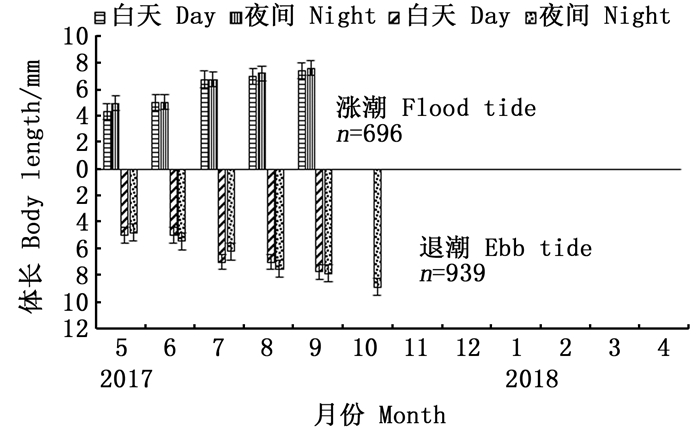
|
图 7 翘嘴鲌各月涨退潮的昼、夜体长变化分布 Fig. 7 Monthly variations in body length distribution of Culter alburnus at day and night in the southbranch of Yangtze River estuary |
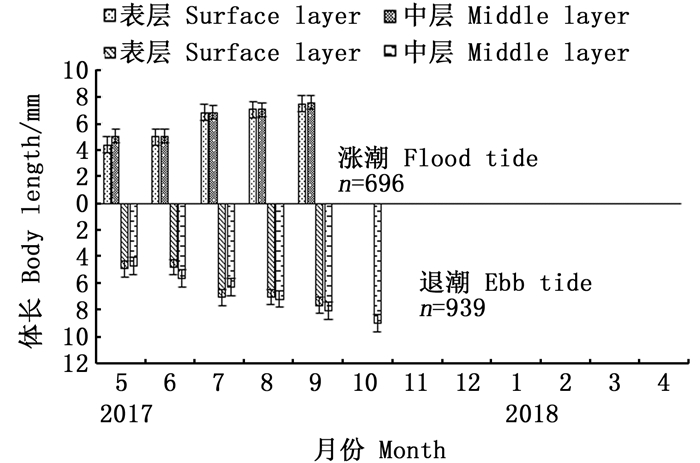
|
图 8 翘嘴鲌各月涨退潮的表、中层体长变化分布 Fig. 8 Monthly variations in body length distribution of Culter alburnus in the surface and middle layers inthe south branch of Yangtze River estuary |
子陵吻虾虎鱼仔稚鱼体长在白天的整体分布大于夜间, 表、中层差异不明显, 除2018年1月—2018年4月无子陵吻虾虎鱼仔稚鱼渔获外, 子陵吻虾虎鱼在5月、6月体长最小, 7月开始显著升高, 直至同年12月其体长均保持在相对较高水平。此外, 涨潮时, 除5、6月昼夜体长表现为夜间大于白天外, 其余子陵吻虾虎鱼渔获月份中, 白天的体长长度整体略高于夜间, 见图 9, 10。

|
图 9 子陵吻虾虎鱼各月涨退潮的昼、夜体长变化分布 Fig. 9 Monthly variations in body length distribution of Rhinogobius giurinus at day and night in thesouth branch of Yangtze River estuary |

|
图 10 子陵吻虾虎鱼各月涨退潮的表、中层体长变化分布 Fig. 10 Monthly variations in body length distribution of Rhinogobius giurinusin in the surface and middlelayers in the south branch of Yangtze River estuary |
香䲗仔稚鱼体长在涨潮时表现为夜间整体大于白天, 退潮时白天大于夜间, 涨潮时仅在7月表现为中层显著高于表层, 其余各月整体表现为表层高于中层, 香䲗仔稚鱼体长5月、6月无明显变化, 从7月开始, 其体长开始显著上升, 见图 11, 12。
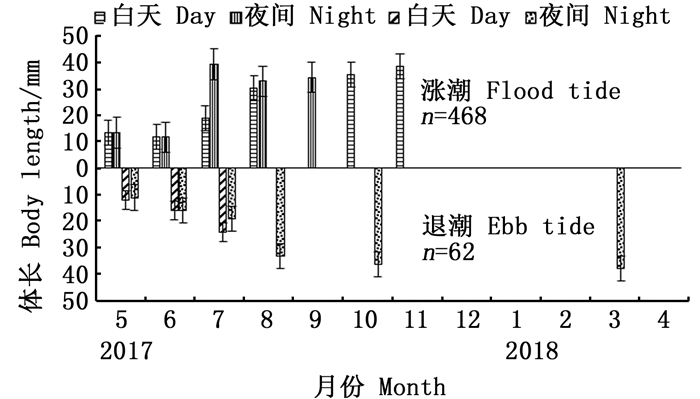
|
图 11 香䲗各月涨退潮的昼、夜体长变化分布 Fig. 11 Monthly variations in body length distribution of Repomucenus olidus at day and night inthe south branch of Yangtze River estuary |
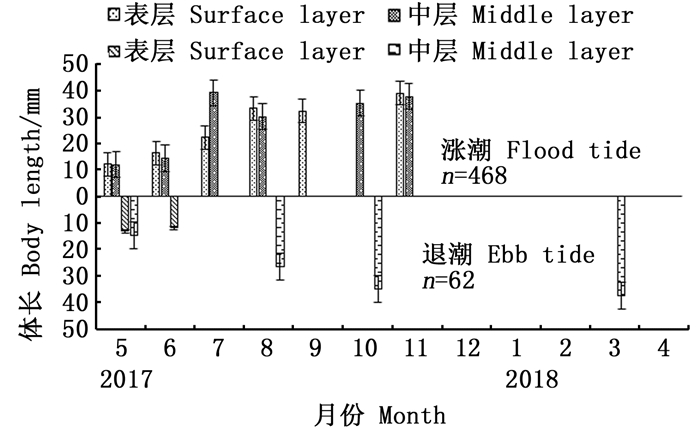
|
图 12 香䲗各月涨退潮的表、中层体长变化分布 Fig. 12 Monthly variations in body length distribution of Repomucenus olidusin the surface and middlelayers in the south branch of Yangtze River estuary |
发育阶段分析(图 13)结果表明, 长江口南支贝氏䱗仔稚鱼主要渔获月份中, 无论涨潮还是退潮, 5—7月均以前弯曲期仔鱼为主, 8月以后弯曲期及后弯曲期仔鱼开始较高频率出现, 表现为退潮时弯曲期贝氏䱗仔稚鱼捕获量高于涨潮时, 后弯曲期仔鱼低于涨潮时。此外, 弯曲期、后弯曲期贝氏䱗仔稚鱼刚开始高频率出现的捕获月份, 均表现为退潮时弯曲期贝氏䱗仔稚鱼的捕获量显著高于涨潮时, 后弯曲期贝氏䱗仔稚鱼的捕获量显著低于涨潮时。

|
图 13 各优势种的涨退潮发育阶段分布 Fig. 13 Distribution of the developmental stage compositions in tide of dominantspecies in the south branch of Yangtze River estuary |
长江口南支鲫仔稚鱼主要渔获月份中, 无论涨潮还是退潮, 5月均以前弯曲期仔鱼为主, 7—9月弯曲期及后弯曲期的仔稚鱼开始较高频率出现, 且表现为7月退潮时弯曲期鲫仔稚鱼捕获量高于涨潮时, 8月落潮时后弯曲期鲫仔稚鱼低于涨潮时, 9月涨潮时弯曲期鲫仔稚鱼捕获量高于落潮时。此外, 弯曲期、后弯曲期鲫仔稚鱼刚开始高频率出现的捕获月份, 均表现为退潮时弯曲期鲫仔稚鱼的捕获量显著高于涨潮时, 后弯曲期鲫仔稚鱼的捕获量低于涨潮时。
长江口南支翘嘴鲌仔稚鱼主要渔获月份中, 无论涨潮还是退潮, 5月、7月均以前弯曲期仔鱼为主; 6月弯曲期仔鱼开始较高频率出现, 8月、9月主要以弯曲期仔鱼为主, 后弯曲期仔鱼开始较高频率出现, 主要表现为6月弯曲期仔鱼涨潮时捕获量高于退潮时, 8月退潮时弯曲期及后弯曲期仔鱼捕获量高于涨潮时, 9月退潮时后弯曲期翘嘴鲌仔稚鱼低于涨潮时。此外, 除6月外, 弯曲期翘嘴鲌仔稚鱼刚开始高频率出现的捕获月份, 表现为退潮时高于涨潮时, 总体后弯曲期翘嘴鲌仔稚鱼捕获量涨潮时高于退潮时。
长江口南支子陵吻虾虎鱼仔稚鱼主要渔获月份中, 无论涨潮还是退潮, 5月均以前弯曲期仔鱼为主, 6月弯曲期仔鱼所占子陵吻虾虎鱼发育阶段比重显著升高, 7月后子陵吻虾虎鱼仔稚鱼发育阶段组成则以后弯曲仔稚鱼为主。此外, 弯曲期及后弯曲期子陵吻虾虎鱼仔鱼刚开始高频率出现的捕获月份, 均表现为退潮时显著高于涨潮时。
长江口南支香䲗仔稚鱼主要渔获月份中, 无论涨潮还是退潮, 5月均以前弯曲期仔鱼为主, 退潮时的弯曲期仔鱼渔获量高于涨潮时, 后弯曲低于涨潮时。
2.5 生态类型从各月“涨退潮”情况下仔稚鱼的生态类型分布(图 14)看, 淡水、半咸水、近海等3种生态类型的鱼类在涨潮时的总体捕获量均大于退潮时, 其中淡水鱼类21种, 占总渔获量的99.82%, 半咸水鱼类7种(2.15%), 近海鱼类4种(0.18%), 淡水鱼类在7月捕获量最高, 近海鱼类5、6月最高, 半咸水鱼类5月最高。
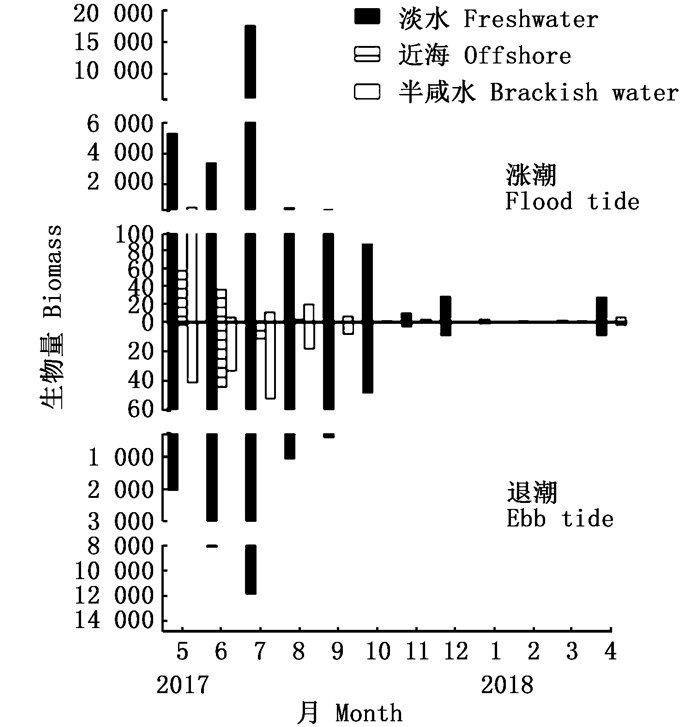
|
图 14 各月涨退潮情况下仔稚鱼的生态类型分布 Fig. 14 Monthly distributions of ecological guilds inthe south branch of Yangtze River estuary |
综合图 2以及图 15并辅以SPSS Pearson相关性分析结果可知, 长江口南支溶氧浓度、温度与平均密度之间均存在极显著相关性(|r|>0.8), 与盐度之间无显著相关性(|r|<0.2)。该结果表明, 长江口南支仔稚鱼的密度分布在较大程度上受溶氧浓度、温度等环境因子影响。
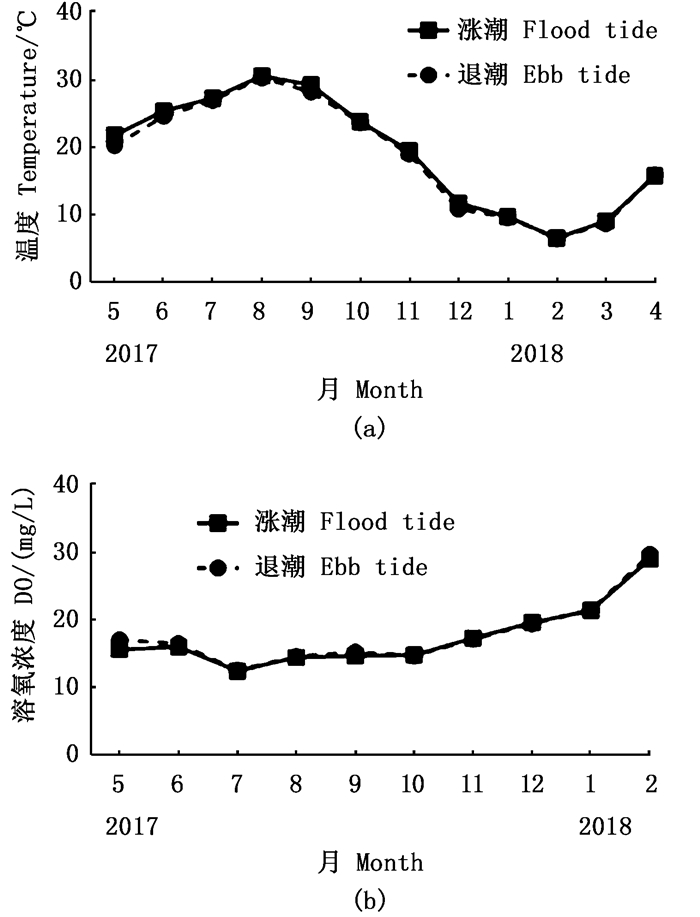
|
图 15 长江口南支水域温度和溶氧浓度的月变化 Fig. 15 Temporal monthly variations in water temperature(a) and DO (b) in the south branchof Yangtze River estuary during the study period |
本研究结果表明, 长江口南支主要以淡水鲤科鱼类为主, 其中以贝氏䱗为最优势种, 这与近几年长江口南支仔稚鱼种类组成的相关研究[13, 31]结果一致。长江口南支仔稚鱼的平均密度一定程度上受“涨退潮”、“昼夜”、“表中水层”变化影响, 总体表现为涨潮高于退潮、白天高于夜间、表层高于中层, 其全年密度分布存在明显的月间差异。基于“涨退潮”对5个优势种平均体长进行“昼、夜”、“表、中层”分析比较, 我们发现长江口南支仔稚鱼的平均体长分布与潮汐显著相关, 与“昼、夜”、“表、中层”存在一定程度相关性。发育阶段分布结果表明, 退潮时, 贝氏䱗、鲫、子陵吻虾虎鱼、香䲗的前弯曲期发育到弯曲期仔鱼大量出现(相对各月各物种相应渔获量), 而后弯曲期仔鱼则在涨潮时大量出现; 分析各月“涨退潮”仔稚鱼出现情况, 除前弯曲期外, 5个优势种的弯曲期仔鱼均为退潮高于涨潮, 后弯曲期仔鱼退潮低于涨潮。生态类型分析结果表明, 淡水、半咸水、近海3种生态类型的鱼类在涨潮时的总体捕获量均大于退潮时, 其中淡水鱼类在7月捕获量最高, 近海鱼类5、6月最高, 半咸水鱼类5月最高。
仔稚鱼的这种时空分布差异可能与以下因素有关:(1)仔稚鱼游泳能力弱, 只能被迫随潮汐流动[32]。处于早期发育阶段的鱼类, 由于鳍条发育不完全, 游泳能力相对较弱, 无法进行可选择的自主游动, 一旦受到潮汐影响, 就只能被迫随潮汐进行移动; 随着仔稚鱼发育阶段的改变, 仔稚鱼的游泳能力随之上升, 因此, 就有可能导致处于发育后期的仔稚鱼涨退潮密度分布差异小于处于前弯曲期或弯曲期仔鱼的密度分布差异。(2)仔稚鱼存在某种自我保护机制。由于不同仔稚鱼物种、同一仔稚鱼不同发育阶段个体对光线照射的敏感性不同[33-34], 为避免光线对其产生伤害, 仔稚鱼会进行不同程度避光行为。(3)仔稚鱼存在夜间弱视与进食时间节律。仔稚鱼的摄食习惯具有明显的昼夜性, 主要可分为夜间摄食及白天摄食两种类型, 这种摄食习性的选择也会对仔稚鱼的昼夜密度分布产生影响, 且由于夜间光线较暗, 部分夜视能力弱的仔稚鱼在夜间无法进行觅食, 因此只能选择在白天进行摄食, 这就有可能导致仔稚鱼的平均密度呈现昼夜密度差异[35-38]。(4)鱼类自身繁殖特性。为使后代尽可能地获得成活率更高的生存环境, 鱼类产卵时间会根据水文环境的不同而略有差异[39-40]。李树国等[41]对蒙古呼伦湖贝氏䱗的繁殖特性进行了相关的生物学研究, 结果表明, 蒙古呼伦湖贝氏䱗具有显著集群性, 主要生活在水体上层, 繁殖季节主要为6月下旬—7月末, 产卵温度约为22 ℃, 产卵旺盛期为7月中旬。李德尚等[42]研究表明, 在山东及山西地区, 贝氏䱗主要生殖季节为每年的6—7月, 繁殖水温约为22~24 ℃, 降雨量、生境饵料状况、温度、生境中较大型凶猛鱼类的生物量均会较大程度地影响或限制贝氏䱗种群的生物量。余文娟等[43]对长江中游贝氏䱗的繁殖特性进行了相关的生物学研究, 结果表明, 长江中游贝氏䱗的产卵方式为分批产卵, 其繁殖季节主要为4—6月。李忠利等[44]分析讨论了锦江水域翘嘴鲌的繁殖特性, 研究表明, 翘嘴鲌采取分批产卵方式, 主要繁殖期集中在每年6—7月。(5)水文影响。贝氏䱗仔稚鱼密度最高的5—7月水域温度均在20~28 ℃, 密度最高月份的平均水温约为27 ℃, 一旦水域温度低于20 ℃或高于30 ℃, 贝氏䱗仔稚鱼密度就会显著降低; 最适溶氧浓度为6~8 mg/L, 密度最高月份的平均溶氧浓度约为6.24 mg/L, 一旦溶氧浓度超过10 mg/L, 则贝氏䱗密度基本趋近于0。鲫仔稚鱼密度最高月份的平均水温约为21 ℃, 溶氧浓度约为8.44 mg/L, 若水温低于15 ℃, 鲫仔稚鱼渔获量基本为零。翘嘴鲌密度最高月份为5—7月, 对应水域温度为20~30 ℃, 溶氧浓度为6.10~8.60 mg/L, 此结果与李忠利等[44]研究结果大致相同。子陵吻虾虎鱼种群密度最高月份平均溶氧浓度约为8.15 mg/L, 当溶氧浓度高于10.00 mg/L时, 子陵吻虾虎鱼渔获量为零, 其最适温度为24~26 ℃, 若温度低于10 ℃, 长江口南支水域无子陵吻虾虎鱼仔稚鱼渔获。相关性分析结果也表明, 溶氧浓度、温度与平均密度之间均存在显著相关性, 与盐度之间无显著相关性。这是由于:本次研究两个站位点之间间距较近且位于长江口南支中游河段, 受长江径流及冲淡水影响较大, 北支倒灌影响较小, 长江口南支全年各月份盐度均较低, 差异性较小[40]; 水温、潮汐、溶氧浓度、径流等环境因子对浮游生物丰度及种类组成产生一定影响[45-47], 而依赖于浮游生物为食饵的仔稚鱼密度可能随浮游生物丰度及种类的改变而发生变化。
| [1] |
庄平, 罗刚, 张涛, 等. 长江口水域中华鲟幼鱼与6种主要经济鱼类的食性及食物竞争[J]. 生态学报, 2010, 30(20): 5544-5554. ZHUANG P, LUO G, ZHANG T, et al. Food comparison among juvenile Acipenser sinensis and other six economic fishes in the Yangtze estuary[J]. Acta Ecologica Sinica, 2010, 30(20): 5544-5554. |
| [2] |
冯广朋, 庄平, 刘健, 等. 祟明东滩团结沙鱼类群落多样性与生长特性[J]. 海洋渔业, 2007, 29(1): 38-43. FENG G P, ZHUANG P, LIU J, et al. Community diversity and growth characteristic of fish in Tuanjiesha along the eastern beach of Chongming Island[J]. Marine Fisheries, 2007, 29(1): 38-43. |
| [3] |
唐文乔, 诸廷俊, 陈家宽, 等. 长江口九段沙湿地的鱼类资源及其保护价值[J]. 上海水产大学学报, 2003, 12(3): 193-200. TANG W Q, ZHU T J, CHEN J K, et al. Resources and conservation valuation of fishes of Jiuduansha wetland in Changjiang River estuary[J]. Journal of Shanghai Fisheries University, 2003, 12(3): 193-200. |
| [4] |
许秋寒, 钱佳欢, 陈钊英, 等. 长江口及毗邻海域水环境现状与污染防治对策[J]. 中国发展, 2015, 15(3): 10-14. XU Q H, QIAN J H, CHEN Z Y, et al. Water environment status and pollution prevention and control in Yangtze River estuary and adjacent waters[J]. China Development, 2015, 15(3): 10-14. |
| [5] |
曹文宣. 长江鱼类早期资源[M]. 北京: 中国水利水电出版社, 2007. CAO W X. Fish resources of early life history stages in Yangtze River[M]. Beijing: China Water Power Press, 2007. |
| [6] |
殷名称. 鱼类早期生活史研究与其进展[J]. 水产学报, 1991, 15(4): 348-358. YIN M C. Advances and studies on early life history of fish[J]. Journal of Fisheries of China, 1991, 15(4): 348-358. |
| [7] |
闫茂仓, 单乐州, 绍鑫斌, 等. 盐度和pH对鮸鱼幼鱼耗氧率和氨氮排泄率的影响[J]. 台湾海峡, 2007, 26(1): 85-91. YAN M C, SHAN L Z, SHAO X B, et al. Influence of salinity and pH on the rates of oxygen consumption and ammonia excretion of juvenile Miichthy mijuy[J]. Journal of Oceanography in Taiwan Strait, 2007, 26(1): 85-91. |
| [8] |
杨凯, 樊启学, 张磊, 等. 溶氧水平对黄颡鱼稚鱼摄食、生长及呼吸代谢的影响[J]. 淡水渔业, 2010, 40(2): 24-29. YANG K, FAN Q X, ZHANG L, et al. Effects of dissolved oxygen on feed intake, growth and respiratory metabolism of juvenile Pelteobagrus fulvidraco R.[J]. Freshwater Fisheries, 2010, 40. |
| [9] |
刘守海, 王金辉, 刘材材, 等. 长江口水域夏季鱼卵和仔稚鱼年间变化[J]. 生态学报, 2015, 35(21): 7190-7197. LIU S H, WANG J H, LIU C C, et al. Inter-annual variation in pelagic fish egg, larval, and juvenile assemblages during summer in the Yangtze River Estuary, China[J]. Acta Ecologica Sinica, 2015, 35(21): 7190-7197. |
| [10] |
丁月旻, 线薇微. 秋季长江口鱼类浮游生物群落时空结构[J]. 中国海洋大学学报, 2011, 41(10): 67-74. DING Y M, XIAN W W. Temporal and spatial structure of ichthyoplankton assembleges in the Yangtze estuary during autumn[J]. Periodical of Ocean University of China, 2011, 41(10): 67-74. |
| [11] |
钟俊生, 郁蔚文, 刘必林, 等. 长江口沿岸碎波带仔稚鱼种类组成和季节性变化[J]. 上海水产大学学报, 2005, 14(4): 375-382. ZHONG J S, YU W W, LIU B L, et al. Seasonal occurrences of fish larvae and juveniles in the surf zone of the Yangtze River estuary[J]. Journal of Shanghai Fisheries University, 2005, 14(4): 375-382. |
| [12] |
蒋日进, 钟俊生, 张冬良, 等. 长江口沿岸碎波带仔稚鱼的种类组成及其多样性特征[J]. 动物学研究, 2008, 29(3): 297-304. JIANG R J, ZHONG J S, ZHANG D L, et al. Species composition and diversity of fish larvae and juveniles in the surf zone of the Yangtze River estuary[J]. Zoological Research, 2008, 29(3): 297-304. |
| [13] |
李安东.长江口南支仔稚鱼种类组成及其空间变化[D].上海: 上海海洋大学, 2016. LI A D. Characteristic comparison of fish larvae and juvenile assemblages in the southern branch of Yangtze River estuary[D]. Shanghai: Shanghai Ocean University, 2016. |
| [14] |
李建生, 凌建忠, 胡芬. 长江口近岸水域小黄鱼仔稚鱼时空分布和生长特征[J]. 海洋渔业, 2018, 40(4): 404-412. LI J S, LING J Z, HU F. Temporal and spatial distribution and growth characteristics of Larimichthys polyactis larvae and juveniles in the coastal waters of the Yangtze River Estuary[J]. Marine Fisheries, 2018, 40(4): 404-412. |
| [15] |
李建生, 林楠, 凌建忠. 春夏季长江口邻近水域仔稚鱼种类组成和丰度的月变化[J]. 中国水产科学, 2018, 25(3): 586-594. LI J S, LIN N, LING J Z. Temporal variation in the composition and abundance of fish larvae and juveniles off the Yangtze River Estuary in spring and summer[J]. Journal of Fishery Sciences of China, 2018, 25(3): 586-594. |
| [16] |
沖山宗雄. 日本産稚魚図鑑[M]. 東京: 東海大学出版社, 1988. OKIYAMA M. An atlas of the early stage fishes in Japan[M]. Tokyo: Tokai University Press, 1988. |
| [17] |
张仁斋, 陆穗芳. 中国近海鱼卵与仔鱼[M]. 上海: 上海科学技术出版社, 1985. ZHANG R Z, LU S F. Fish eggs and larvae in the offshore waters of China[M]. Shanghai: Shanghai Scientific and Technical Publishers, 1985. |
| [18] |
倪勇, 伍汉霖. 江苏鱼类志[M]. 北京: 中国农业出版社, 2006. NI Y, WU H L. Fishes of Jiangsu Province[M]. Beijing: China Agriculture Press, 2006. |
| [19] |
许成玉, 倪勇. 福建鱼类志:上卷[M]. 福州: 福建科学技术出版社, 1984. XU Y C, NI Y. Fishes of Fujian Province[M]. Fuzhou: Fujian Science & Technology Publishing House, 1984. |
| [20] |
乐佩琦. 中国动物志硬骨鱼纲鲤形目-下卷-硬骨鱼纲, 鲤形目[M]. 北京: 科学出版社, 2000. YUE P Q. Fauna Sinica[M]. Beijing: Science Press, 2000. |
| [21] |
沈世杰. 台湾鱼类志[M]. 中国台北: 台湾大学动物学系, 1993. SHEN S J. Fishes of Taiwan[M]. Taipei of China: Department of Zoology, Taiwan University, 1993. |
| [22] |
KENDALL A W J, AHLSTROM E H, MOSER H G. Early life history stages of fishes and their characters[M]//MOSER H G, RICHARDS W J, COHEN D M, et al. Ontogeny and Systematics of Fishes. The American Society of Ichthyologists Herpetologists. Lawrence: Allen Press, 1984.
|
| [23] |
NELSON J S. Fishes of the world[M]. 4th ed.. New Jersey: John Wiley & Sons Inc, 2006.
|
| [24] |
伍汉霖, 邵广昭, 赖春福, 等. 拉汉世界鱼类系统名典[M]. 中国基隆: 水产出版社, 2012. WU H L, SHAO G Z, LAI C F, et al. Latin-Chinese dictionary of fish names by classification system[M]. Keelung of China: Fisheries Publication, 2012. |
| [25] |
庄平, 王幼槐, 李圣法, 等. 长江口鱼类[M]. 上海: 上海科学技术出版社, 2006. ZHUANG P, WANG Y H, LI S F, et al. Fishes of the Yangtze estuary[M]. Shanghai: Shanghai Scientific and Technical Publishers, 2006. |
| [26] |
梁玉波, 宁修仁, 王长云. 海洋生物生态调查技术规程[M]. 北京: 海洋出版社, 2006. LIANG Y B, NING X R, WANG C Y. The survey of technical specification for marine bioecological survey[M]. Beijing: Ocean Press, 2006. |
| [27] |
钟俊生, 吴美琴, 练青平. 春、夏季长江口沿岸碎波带仔稚鱼的种类组成[J]. 中国水产科学, 2007, 14(3): 436-443. ZHONG J S, WU M Q, LIAN Q P. Composition of fish larvae and juveniles in spring and summer in surf zone of Yangtze River estuary[J]. Journal of Fishery Sciences of China, 2007, 14(3): 436-443. |
| [28] |
张衡, 杨胜龙, 孟海星. 长江口水域鱼卵、仔稚鱼种类组成和数量的分布与变化[J]. 动物学研究, 2012, 33(3): 255-260. ZHANG H, YANG S L, MENG H X. Distribution and changes in species composition and abundance of ichthyoplankton in the Yangtze Estuary[J]. Zoological Research, 2012, 33(3): 255-260. |
| [29] |
徐兆礼, 袁骐, 蒋玫, 等. 长江口鱼卵和仔、稚鱼的初步调查[J]. 中国水产科学, 1999, 6(5): 63-64. XU Z L, YUAN Q, JIANG M, et al. An investigation of fish eggs, larvae and juveniles in the Changjiang Esturary[J]. Journal of Fishery Sciences of China, 1999, 6(5): 63-64. |
| [30] |
陈渊戈, 张宇, 钟俊生, 等. 长江口南支和杭州湾北岸碎波带水域仔稚鱼群聚的比较[J]. 上海海洋大学学报, 2011, 20(5): 688-696. CHEN Y G, ZHANG Y, ZHONG J S, et al. Comparison in fish larvae and juvenile assemblages between the surf zones of south branch of Yangtze River Estuary and north coast of Hangzhou Bay[J]. Journal of Shanghai Ocean University, 2011, 20(5): 688-696. |
| [31] |
侯世挺, 钟俊生, 王晓东, 等. 长江口南支仔稚鱼数量随潮汐变化的研究[J]. 上海海洋大学学报, 2018, 27(2): 250-258. HOU S T, ZHONG J S, WANG X D, et al. The study on the amount changes of fish larvae during flood and ebb in the south branch of Yangtze River Estuary[J]. Journal of Shanghai Ocean University, 2018, 27(2): 250-258. |
| [32] |
唐明英, 黄德林, 黄立章, 等. 草、青、鲢、鳙鱼卵水力学特性试验及其在三峡库区孵化条件初步预测[J]. 水利渔业, 1989(4): 26-30. TANG M Y, HUANG D L, HUANG L Z, et al. Hydraulic characteristics test of grass carp, black carp, silver carp and bighead carp eggs and preliminary prediction of hatching conditions in the Three Gorges Reservoir area[J]. Reservoir Fisheries, 1989(4): 26-30. |
| [33] |
单保党, 何大仁. 黑鲷视觉发育与摄食的关系[J]. 台湾海峡, 1995, 14(2): 169-173. SHAN B D, HE D R. The relation between feeding and vision development of Black porgy[J]. Journal of Oceanography in Taiwan Strait, 1995, 14(2): 169-173. |
| [34] |
单保党, 何大仁. 黑鲷化学感觉发育和摄食关系[J]. 厦门大学学报(自然科学版), 1995, 34(5): 835-839. SHAN B D, HE D R. The relation between the feeding and the development of the chemoreception of black porgy[J]. Journal of Xiamen University (Natural Science), 1995, 34(5): 835-839. |
| [35] |
雷霁霖. 海水鱼类养殖理论与技术[M]. 北京: 中国农业出版社, 2005. LEI J L. Marine fish culture theory and techniques[M]. Beijing: China Agriculture Press, 2005. |
| [36] |
FONDS M, TANAKA M, VAN DER VEER H W. Feeding and growth of juvenile Japanese flounder Paralichthys olivaceus in relation to temperature and food supply[J]. Netherlands Journal of Sea Research, 1995, 34(1/3): 111-118. |
| [37] |
马爱军, 柳学周, 徐永江, 等. 半滑舌鳎(Cynoglossus semilaevis)早期发育阶段的摄食特性及生长研究[J]. 海洋与湖沼, 2005, 36(2): 130-138. MA A J, LIU X Z, XU Y J, et al. Study on feeding behavior and growth of tongue sole Cynoglossus semilaevis in early development stage[J]. Oceanologia et Limnologia Sinica, 2005, 36(2): 130-138. |
| [38] |
李大勇, 刘晓春, 何大仁. 真鲷早期发育阶段的摄食节律[J]. 热带海洋, 1994, 13(2): 82-87. LI D Y, LIU X C, HE D R. Feeding rhythm of Pagrosomus major during the early development stage[J]. Tropic Oceanology, 1994, 13(2): 82-87. |
| [39] |
殷名称. 鱼类生态学[M]. 北京: 中国农业出版社, 1995. YIN M C. Fish ecology[M]. Beijing: China Agriculture Press, 1995. |
| [40] |
毛成责, 陈渊戈, 钟俊生, 等. 长江口南支邻近水域碎波带仔稚鱼群落结构的差异及关联[J]. 长江流域资源与环境, 2018, 27(1): 125-134. MAO C Z, CHEN Y G, ZHONG J S, et al. Differences and association of larval and juvenile fish community in surf zone of south branch of Yangtze River and the adjacent waters[J]. Resources and Environment in the Yangtze Basin, 2018, 27(1): 125-134. |
| [41] |
李树国, 张全诚, 高庆全, 等. 呼伦湖蒙古油繁殖生物学的研究[J]. 淡水渔业, 2008, 38(5): 51-54. LI S G, ZHANG Q C, GAO Q Q, et al. Study reproductive biology of Hemiculter bleekeri warpachowskyi in Hulun Lake of Inner Mongolia[J]. Freshwater Fisheries, 2008, 38(5): 51-54. |
| [42] |
李德尚, 吴雄飞, 谢宗墉, 等. 杂鱼在养鱼水库中的作用及其种群控制[J]. 生态学报, 1988, 8(4): 304-310. LI D S, WU X F, XIE Z R, et al. Role of minnows in fish-farming reservoirs and control of their populations[J]. Acta Ecologica Sinica, 1988, 8(4): 304-310. |
| [43] |
余文娟, 沈建忠, 龚江, 等. 长江中游贝氏䱗繁殖生物学研究[J]. 淡水渔业, 2018, 48(3): 53-60. YU W J, SHEN J Z, GONG J, et al. Reproductive biology of Hemiculter bleekeri in the middle reaches of the Yangtze River[J]. Freshwater Fisheries, 2018, 48(3): 53-60. |
| [44] |
李忠利, 冉辉, 杨马, 等. 锦江翘嘴鲌的繁殖生物学特征[J]. 动物学杂志, 2017, 52(2): 263-270. LI Z L, RAN H, YANG M, et al. Reproductive biology of Topmouth Culter (Culter alburnus) in Jinjiang River[J]. Chinese Journal of Zoology, 2017, 52(2): 263-270. |
| [45] |
高雷.长江口南支鱼类早期资源多样性与时空格局研究[D].武汉: 中国科学院水生生物研究所, 2014. GAO L. Diversity and temporal and spatial patterns of larval fish assemblages in the south branch of Yangtze Estuary[D]. Wuhan: Institute of Hydrobiology Chinese Academy of Sciences, 2014. |
| [46] |
上官欣欣, 薛俊增, 吴惠仙. 长江口浮游植物群落结构的特征[J]. 上海海洋大学学报, 2019, 28(5): 689-698. SHANGGUAN X X, XUE J Z, WU H X. Ecological features of phytoplankton community in the Yangtze River Estuary[J]. Journal of Shanghai Ocean University, 2019, 28(5): 689-698. |
| [47] |
胡敏, 钟俊生, 唐子涵, 等. 杭州湾北部水域仔稚鱼组成的月度及年间比较[J]. 上海海洋大学学报, 2017, 26(1): 103-112. HU M, ZHONG J S, TANG Z H, et al. Monthly and annual comparison of fish larvae and juveniles composition in the north of Hangzhou Bay[J]. Journal of Shanghai Ocean University, 2017, 26(1): 103-112. |
 2020,
Vol. 29
2020,
Vol. 29


